Magnetoelectric Properties of Aurivillius-Layered Perovskites
Abstract
1. Introduction
2. Materials and Methods
3. Results and Discussion
3.1. Powder X-ray Diffraction and Morphological Studies
3.2. Morphological Studies
3.3. Raman Spectroscopic Studies
3.4. Dielectric Studies
3.5. Electrical Studies
3.6. Magnetic Studies
3.7. Magnetoelectric Studies
4. Conclusions
Author Contributions
Funding
Data Availability Statement
Acknowledgments
Conflicts of Interest
References
- Nan, C.W.; Bichurin, M.I.; Dong, S.; Viehland, D.; Srinivasan, G. Multiferroic magnetoelectric composites: Historical perspective, status, and future directions. J. Appl. Phys. 2008, 103, 031101. [Google Scholar] [CrossRef]
- Bibes, M.; Barthélémy, A. Multiferroics: Towards a magnetoelectric memory. Nat. Mater. 2008, 7, 425. [Google Scholar] [CrossRef]
- Dong, S.; Liu, J.M.; Cheong, S.W.; Ren, Z. Multiferroic materials and magnetoelectric physics: Symmetry, entanglement, excitation, and topology. Adv. Phys. 2015, 64, 519. [Google Scholar] [CrossRef]
- Fiebig, M.; Lottermoser, T.; Meier, D.; Trassin, M. The evolution of multiferroics. Nat. Rev. Mater. 2016, 1, 16046. [Google Scholar] [CrossRef]
- Khomskii, D. Classifying multiferroics: Mechanisms and Effects. Physics 2009, 2, 20. [Google Scholar] [CrossRef]
- Spaldin, N.A. Multiferroics: Past, present, future. MRS Bull. 2017, 42, 385. [Google Scholar] [CrossRef]
- Jana, B.; Ghosh, K.; Rudrapal, K.; Gaur, P.; Shihabudeen, P.K.; Roy Chaudhuri, A. Recent Progress in Flexible Multiferroics. Front. Phys. 2022, 9, 822005. [Google Scholar] [CrossRef]
- Scott, J.F. Data storage: Multiferroic memories. Nat. Mater. 2007, 6, 256. [Google Scholar] [CrossRef]
- Kreisel, J.; Kenzelmann, M. Multiferroics—The challenge of coupling magnetism and ferroelectricity. Europhys. News 2009, 40, 17. [Google Scholar] [CrossRef]
- Sahoo, R.R.; Choudhary, R.N.P. Effect of Ce infusion on the structural, dielectric, optical, transport and polarization behavior of Nd-modified triple-layered Aurivillius phase ceramic Bi3NdTi3O12. Ceram. Int. 2024, 50, 205. [Google Scholar] [CrossRef]
- Subbarao, E.C. A family of ferroelectric bismuth compounds. J. Phys. Chem. Solids 1962, 23, 665. [Google Scholar] [CrossRef]
- Wang, G.; Huang, Y.; Sun, S.; Wang, J.; Peng, R.; Lu, Y.; Tan, X. Layer Effects on the Magnetic Behaviors of Aurivillius Compounds Bin+1Fen-3Ti3O3n+1 (n = 6, 7, 8, 9). J. Am. Ceram. Soc. 2016, 99, 1318. [Google Scholar] [CrossRef]
- Khomchenko, V.A.; Kakazei, G.N.; Pogorelov, Y.G.; Araujo, J.P.; Bushinsky, M.V.; Kiselev, D.A.; Kholkin, A.L.; Paixão, J.A. Effect of Gd substitution on ferroelectric and magnetic properties of Bi4Ti3O12. Mater. Lett. 2010, 64, 1066. [Google Scholar] [CrossRef]
- Hou, D.; Fan, H.; Chen, Y.; Jia, Y.; Wang, W. Effects of lanthanide ions on the structure and electrical properties of Aurivillius Bi3TiNbO9 high temperature piezoelectric ceramics. J. Alloys Compd. 2022, 921, 166065. [Google Scholar] [CrossRef]
- Sun, J.; Han, Y.; Gao, G.; Yang, J.; Zhang, Y.; Dai, Y.; Song, D. Breakdown field enhancement and energy storage performance in four-layered Aurivillius films. Ceram. Int. 2022, 48, 15780. [Google Scholar] [CrossRef]
- Li, Z.; Koval, V.; Mahajan, A.; Gao, Z.; Vecchini, C.; Stewart, M.; Cain, M.G.; Tao, K.; Jia, C.; Viola, G.; et al. Room-temperature multiferroic behavior in layer-structured Aurivillius phase ceramics. Appl. Phys. Lett. 2020, 117, 52903. [Google Scholar] [CrossRef]
- Supriya, S. Effect of doping and enhanced microstructures of bismuth titanates as Aurivillius perovskites. Micron 2022, 162, 103344. [Google Scholar] [CrossRef]
- Kikuchi, T.; Watanabe, A.; Uchida, K. A Family of Mixed-Layer Type Bismuth Compounds; Pergamon Press, Inc.: Oxford, UK, 1977; Volume 12, p. 299. [Google Scholar]
- Zhao, H.; Cai, K.; Cheng, Z.; Jia, T.; Kimura, H.; Ma, Z.; Fu, Q.; Huang, Z.; Matsumoto, T.; Tohei, T.; et al. A novel class of multiferroic material, Bi4Ti3O12·nBiFeO3 with localized magnetic ordering evaluated from their single crystals. Adv. Electron. Mater. 2017, 3, 1600254. [Google Scholar] [CrossRef]
- Veenachary, V.; Puli, V.S.; Babu, S.N.; Prasad, G.; Prasad, N.V. Electrical and magnetic studies on promising Aurivillius intergrowth compound. J. Mater. Sci. Mater. Electron. 2022, 33, 22614. [Google Scholar] [CrossRef]
- Koval, V.; Shi, Y.; Skorvanek, I.; Viola, G.; Bures, R.; Saksl, K.; Roupcova, P.; Zhang, M.; Jia, C.; Yan, H. Cobalt-induced structural modulation in multiferroic Aurivillius-phase oxides. J. Mater. Chem. C 2020, 8, 8466. [Google Scholar] [CrossRef]
- Yin, Y.; Liu, F.; Mao, X.; Wang, W. Multiferroic properties of Bi5.75R0.25Fe1.4Ni0.6Ti3O18 (R = Eu, Sm, Nd, Bi and La) ceramics. J. Rare Earths 2022, 40, 112. [Google Scholar] [CrossRef]
- Hou, R.Z.; Chen, X.M.; Wu, S.Y. Substitution of Sm3+ and Nd3+ for Bi3+ in SrBi8Ti7O27 Mixed Aurivillius Phase. Jpn. J. Appl. Phys. Part 1 Regul. Pap. Short Notes Rev. Pap. 2003, 42, 5169. [Google Scholar] [CrossRef]
- Lomanova, N.A. Aurivillius Phases Bim+1Fem–3Ti3O3m+3: Synthesis, Structure, and Properties (a Review). Russ. J. Inorg. Chem. 2022, 67, 741. [Google Scholar] [CrossRef]
- Patri, S.K.; Choudhary, R.N.P.; Samantaray, B.K. Studies of structural; dielectric, and impedance properties of Bi9Fe5Ti3O27 ceramics. J. Electroceram. 2008, 20, 119. [Google Scholar] [CrossRef]
- Yi, Z.G.; Li, Y.X.; Wang, Y.; Yin, Q.R. Dielectric and ferroelectric properties of intergrowth Bi7-xLaxTi4NbO21 ceramics. Appl. Phys. Lett. 2006, 88, 152909. [Google Scholar] [CrossRef]
- Gao, X.; Gu, H.; Li, Y.X.; Yi, Z.G.; Čeh, M.; Žagar, K. Structural evolution of the intergrowth bismuth-layered Bi7Ti4NbO21. J. Mater. Sci. 2011, 46, 5423. [Google Scholar] [CrossRef]
- Liu, C.; Chen, Z.; Peng, R.; Fu, Z.; Zhai, X.; Lu, Y. The structure and properties of Co substituted Bi7Ti4NbO21 with intergrowth phases. RSC. Adv. 2017, 7, 50477. [Google Scholar] [CrossRef]
- Giridharan, N.V.; Supriya, S. Effect of processing on the properties of Bi3.15Nd0.85Ti3O12 thin films. Thin Solid Films 2008, 516, 5244. [Google Scholar] [CrossRef]
- Coathup, D.; Li, Z.; Zhu, X.; Yan, H.; Zhang, R.; Ye, H. Dielectric and ferroelectric properties of BTFCO thin films. J. Electroceram. 2019, 43, 92. [Google Scholar] [CrossRef]
- Li, Y.; Li, Z.; Wang, X.; Li, H.; Su, J.; Zhang, H.; He, X.; Chi, Z.; Liu, L. Scaling behavior of dynamic hysteresis in multiferroic Bi5FeTi3O15 thin films. J. Mater. Sci. Mater. Electron. 2021, 32, 27333. [Google Scholar] [CrossRef]
- Prellier, W.; Singh, M.P.; Murugavel, P. The single-phase multiferroic oxides: From bulk to thin film. J. Condens. Matter Phys. 2005, 17, R803. [Google Scholar] [CrossRef]
- Huang, F.; Lu, X.; Xu, T.; Liu, Y.; Su, W.; Jin, Y.; Kan, Y.; Zhu, J. Multiferroic properties of Co and Nd co-substituted Bi5Ti3FeO15 thin films. Thin Solid Films 2012, 520, 6489. [Google Scholar] [CrossRef]
- Ma, S.; Li, W.; Hao, J.; Ren, S.; Wang, M.; Xu, Z. Microstructure and ferroelectric properties of Ta-doped Bi3.25La0.75Ti3O12/ZnO thin film capacitors. Ceram. Int. 2022, 48, 5239. [Google Scholar] [CrossRef]
- Song, D.; Yang, J.; Yang, B.; Chen, L.; Wang, F.; Zhu, X. Evolution of structure and ferroelectricity in Aurivillius Bi4Bin-3Fen-3Ti3O3n+3 thin films. J. Mater. Chem. C 2018, 6, 8618. [Google Scholar] [CrossRef]
- Sun, H.; Lu, X.; Xu, T.; Su, J.; Jin, Y.; Ju, C.; Huang, F.; Zhu, J. Study of multiferroic properties in Bi 5Fe0.5Co0.5Ti3O15 thin films. J. Appl. Phys. 2012, 111, 124116. [Google Scholar] [CrossRef]
- Chen, X.Q.; Yang, F.J.; Cao, W.Q.; Wang, H.; Yang, C.P.; Wang, D.Y.; Chen, K. Enhanced multiferroic characteristics in Fe-doped Bi4Ti3O12 ceramics. Solid State Commun. 2010, 150, 1221. [Google Scholar] [CrossRef]
- Chen, X.Q.; Qiao, Y.; Liu, X.L.; Lu, C.J.; Le Rhun, G.; Senz, S.; Hesse, D. Microstructure and electric properties of (104)/(014)-oriented Bi3.15Nd0.85Ti3O12 films on Pt (111)/Ti/SiO2/Si by sol-gel method. Mater. Lett. 2007, 61, 4897. [Google Scholar] [CrossRef]
- Sharma, N.; Kennedy, B.J.; Elcombe, M.M.; Liu, Y.; Ling, C.D. Coexistence of ferroelectricity and magnetism in transition-metal-doped n = 3 Aurivillius phases. J. Condens. Matter Phys. 2008, 20, 025215. [Google Scholar] [CrossRef]
- Halpin, J.; Keeney, L. Naturally Layered Aurivillius Phases: Flexible Scaffolds for the Design of Multiferroic Materials. OAJ Mater. Dev. 2021, 5, 234. [Google Scholar] [CrossRef]
- Joshi, P.C.; Desu, S.B. Structural and electrical characteristics of rapid thermally processed ferroelectric Bi4Ti3O12 thin films prepared by metalorganic solution deposition technique. J. Appl. Phys. 1996, 80, 2349. [Google Scholar] [CrossRef]
- Li, X.; Zhu, L.; Huang, P.; Chen, Z.; Bai, W.; Li, L.; Wen, F.; Zheng, P.; Wu, W.; Zheng, L.; et al. Reduction of oxygen vacancy concentration and large enhancement of electrical performances in Cu/Sb co-doped Bi4Ti3O12 high-temperature piezoelectric ceramics. J. Appl. Phys. 2020, 127, 044102. [Google Scholar] [CrossRef]
- Bokolia, R.; Thakur, O.P.; Rai, V.K.; Sharma, S.K.; Sreenivas, K. Electrical properties and light upconversion effects in Bi3.79Er0.03Yb0.18Ti3-xWxO12 ferroelectric ceramics. Ceram. Int. 2016, 42, 5718. [Google Scholar] [CrossRef]
- Stojanović, B.D.; Paiva-Santos, C.O.; Cilense, M.; Jovalekić, Č.; Lazarević, Z.Ž. Structure study of Bi4Ti3O12 produced via mechanochemically assisted synthesis. Mater. Res. Bull. 2008, 43, 1743. [Google Scholar] [CrossRef]
- Prasad, N.V.; Prasad, G.; Kumar, G.S.; Karmakar, S.; Gupta, S.M. Electrical relaxation studies on lanthanum and vanadium modified Bi4Ti3O12. Ferroelectrics 2012, 437, 88. [Google Scholar] [CrossRef]
- Lavado, C.; Stachiotti, M.G. Fe3+/Nb5+ co-doping effects on the properties of Aurivillius Bi4Ti3O12 ceramics. J. Alloys Compd. 2018, 731, 914. [Google Scholar] [CrossRef]
- Wang, W.; Shen, X.; Wang, W.; Guan, X.; Yao, Y.; Wang, Y.; Yu, R. The Evolution of Microstructure and Magnetic Properties of the Bismuth Layer Compounds with Cobalt Ions Substitution. Inorg. Chem. 2017, 56, 3207. [Google Scholar] [CrossRef]
- Ferreira, W.C.; Rodrigues, G.L.C.; Araújo, B.S.; de Aguiar, F.A.A.; de Abreu Silva, A.N.A.; Fechine, P.B.A.; de Araujo Paschoal, C.W.; Ayala, A.P. Pressure-induced structural phase transitions in the multiferroic four-layer Aurivillius ceramic Bi5FeTi3O15. Ceram. Int. 2020, 46, 18056. [Google Scholar] [CrossRef]
- Shigyo, T.; Kiyono, H.; Nakano, J.; Itoh, H.; Takahashi, J. Synthesis and dielectric-magnetic properties of rare-earth (La, Nd, Sm)-modified Bi4Ti3O12. Jpn. J. Appl. Phys. 2008, 47, 7617. [Google Scholar] [CrossRef]
- Paul, J.; Bhardwaj, S.; Sharma, K.K.; Kotnala, R.K.; Kumar, R. Room-temperature multiferroic properties and magnetoelectric coupling in Bi4-xSmxTi3-xCoxO12-δ ceramics. J. Mater. Sci. 2014, 49, 6056. [Google Scholar] [CrossRef]
- Yu, Z.; Meng, X.; Zheng, Z.; Lu, Y.; Chen, H.; Huang, C.; Sun, H.; Liang, K.; Ma, Z.; Qi, Y.; et al. Room temperature multiferroic properties of rare-earth-substituted Aurivillius phase Bi5Ti3Fe0.7Co0.3O15 ceramics. Mater. Res. Bull. 2019, 115, 235. [Google Scholar] [CrossRef]
- Chakrabarti, A.; Bera, J. Effect of La-substitution on the structure and dielectric properties of BaBi4Ti4O15 ceramics. J. Alloys Compd. 2010, 505, 668. [Google Scholar] [CrossRef]
- Patri, T.; Kumar, J.P.; Ghosh, A.; Babu, P.D. Tunable polarization with enhanced multiferroic response of W/Co co-doped Bi4LaFeTi3O15 Aurivillius ceramics. J. Appl. Phys. 2020, 128, 154102. [Google Scholar] [CrossRef]
- Algueró, M.; Pérez-Cerdán, M.; del Real, R.P.; Ricote, J.; Castro, A. Novel Aurivillius Bi4Ti3−2xNbxFexO12 phases with increasing magnetic-cation fraction until percolation: A novel approach for room temperature multiferroism. J. Mater. Chem. C 2020, 8, 12457. [Google Scholar] [CrossRef]
- Mandal, T.K.; Sivakumar, T.; Augustine, S.; Gopalakrishnan, J. Heterovalent cation-substituted Aurivillius phases, Bi2SrNaNb2TaO12 and Bi2Sr2Nb3-xMxO12 (M = Zr, Hf, Fe, Zn). Mater. Sci. Eng. B 2005, 121, 112. [Google Scholar] [CrossRef][Green Version]
- Yu, W.J.; Kim, Y.I.; Ha, D.H.; Lee, J.H.; Park, Y.K.; Seong, S.; Hur, N.H. A new manganese oxide with the Aurivillius structure: Bi2Sr2Nb2MnO12−δ. Solid State Commun. 1999, 111, 705. [Google Scholar] [CrossRef]
- Veenachary, V.; Ramana, E.V.; Babu, S.N.; Puli, V.S.; Srinivas, A.; Srinivasan, G.; Saha, S.; Prasad, G.; Prasad, N.V. Magnetic and Magnetoelectric Properties of AurivilliusThree- and Four-Layered Intergrowth Ceramics. Crystals 2023, 13, 426. [Google Scholar] [CrossRef]
- Ramana, E.V.; Prasad, N.V.; Tobaldi, D.M.; Zavašnik, J.; Singh, M.K.; Hortigüela, M.J.; Seabra, M.P.; Prasad, G.; Valente, M.A. Effect of samarium and vanadium co-doping on structure, ferroelectric and photocatalytic properties of bismuth titanate. RSC. Adv. 2017, 7, 9680. [Google Scholar] [CrossRef]
- Hume-Rothery, R. Van Nostrand’s Scientific Encyclopaedia; John Wiley & Sons, Inc.: New York, NY, USA, 2002. [Google Scholar]
- Suárez, D.Y.; Reaney, I.M.; Lee, W.E. Relation between tolerance factor and Tc in Aurivillius compounds. J. Mater. Res. 2001, 16, 3139. [Google Scholar] [CrossRef]
- Zhang, D.L.; Huang, W.C.; Chen, Z.W.; Zhao, W.B.; Feng, L.; Li, M.; Yin, Y.W.; Dong, S.N.; Li, X.G. Structure evolution and multiferroic properties in cobalt doped Bi4NdTi3Fe1-xCoxO15-Bi3NdTi2Fe1-xCoxO12-δ Intergrowth Aurivillius Compounds. Sci. Rep. 2017, 7, 43540. [Google Scholar] [CrossRef] [PubMed]
- Das, S.R.; Dobal, P.S.; Sundarakannan, B.; Das, R.R.; Katiyar, R.S. Micro-Raman study of Zr-substituted Bi4Ti3O12 ceramics. J. Raman Spectrosc. 2007, 38, 1077. [Google Scholar] [CrossRef]
- Wu, D.; Deng, Y.; Mak, C.L.; Wong, K.H.; Li, A.D.; Zhang, M.S.; Ming, N.B. Raman scattering study of La-, Nd- And Sm-substituted Bi4Ti3O12. Appl. Phys. A Mater. Sci. Process. 2005, 80, 607. [Google Scholar] [CrossRef]
- Ti, R.; Lu, X.; He, J.; Huang, F.; Wu, H.; Mei, F.; Zhou, M.; Li, Y.; Xu, T.; Zhu, J. Multiferroic properties and magnetoelectric coupling in Fe/Co co-doped Bi3.25La0.75Ti3O12 ceramics. J. Mater. Chem. C 2015, 3, 11868. [Google Scholar] [CrossRef]
- Ramana, E.V.; Figueiras, F.; Mahajan, A.; Tobaldi, D.; Costa, B.F.O.; Graça, M.P.F.; Valente, M.A. Effect of Fe-doping on the structure and magnetoelectric properties of (Ba0.85Ca0.15)(Ti0.9Zr0.1)O3 synthesized by a chemical route. J. Mater. Chem. C 2016, 4, 1066. [Google Scholar] [CrossRef]
- Yin, Z.; Sheng, Y.; Ma, G. Dielectric, multiferroic and magnetodielectric properties of Co/Fe co-doped Bi4Ti3O12 ceramics. J. Mater. Sci. Mater. Electron. 2019, 30, 10483. [Google Scholar] [CrossRef]
- Long, C.; Ren, W.; Li, Y.; Liu, L.; Xia, Y.; Fan, H. High oxide ion conductivity in layer-structured Bi4Ti3O12-based ferroelectric ceramics. J. Mater. Chem. C 2019, 7, 8825. [Google Scholar] [CrossRef]
- Kumar, J.P.; Sekhar, K.S.K.R.C.; Rao, T.D.; Babu, P.D.; Tirupathi, P. Effect of sintering temperature on structural, dielectric, and electrical property studies of Bi4NdTi3FeO15 Aurivillius ceramics. J. Mater. Sci. Mater. Electron. 2021, 32, 9675. [Google Scholar] [CrossRef]
- Goodenough, J.B. Electronic and ionic transport properties and other physical aspects of perovskites. Rep. Prog. Phys. 2004, 67, 1915. [Google Scholar] [CrossRef]
- Shet, T.; Bhimireddi, R.; Varma, K.B.R. Grain size-dependent dielectric, piezoelectric and ferroelectric properties of Sr2Bi4Ti5O18 ceramics. J. Mater. Sci. 2016, 51, 9253. [Google Scholar] [CrossRef]
- Kumar, S.; Varma, K.B.R. Dielectric relaxation in bismuth layer structured BaBi4Ti4O15 ferroelectric ceramics. Curr. Appl. Phys. 2011, 11, 203. [Google Scholar] [CrossRef]
- Mohapatra, S.R.; Sahu, B.; Badapanda, T.; Pattanaik, M.S.; Kaushik, S.D.; Singh, A.K. Optical, dielectric relaxation and conduction study of Bi2Fe4O9 ceramic. J. Mater. Sci. Mater. Electron. 2016, 27, 3645. [Google Scholar] [CrossRef]
- Patri, T.; Ghosh, A.; Mahesh, M.L.V.; Babu, P.D.; Mandal, S.K.; Singh, M.N. Fortified relaxor ferroelectricity of rare earth substituted 4-layered BaBi3.9RE0.1Ti4O15 (RE = La, Pr, Nd, and Sm) Aurivillius compounds. Sci. Rep. 2022, 12, 16508. [Google Scholar] [CrossRef]
- Zhang, H.; Yan, H.; Ning, H.; Reece, M.J.; Eriksson, M.; Shen, Z.; Kan, Y.; Wang, P. The grain size effect on the properties of Aurivillius phase Bi3.15Nd0.85Ti3O12 Ferroelectric ceramics. Nanotechnology 2009, 20, 385708. [Google Scholar] [CrossRef]
- Nayak, P.; Badapanda, T.; Singh, A.K.; Panigrahi, S. Possible relaxation and conduction mechanism in W6+doped SrBi4Ti4O15 ceramic. Ceram Int. 2017, 43, 4527. [Google Scholar] [CrossRef]
- Rehman, F.; Li, J.B.; Dou, Y.K.; Zhang, J.S.; Zhao, Y.J.; Rizwan, M.; Khalid, S.; Jin, H.B. Dielectric relaxations and electrical properties of Aurivillius Bi3.5La0.5Ti2Fe0.5Nb0.5O12 ceramics. J. Alloys Compd. 2016, 654, 315. [Google Scholar] [CrossRef]
- Thomas, A.K.; Abraham, K.; Thomas, J.; Saban, K.V. Electrical and dielectric behaviour of Na0.5La0.25Sm0.25Cu3Ti4O12 ceramics investigated by impedance and modulus spectroscopy. J. Asian Ceram. Soc. 2017, 5, 56. [Google Scholar] [CrossRef]
- Rehman, F.; Li, J.B.; Ahmed, P.; Khan, M.S.; Saeed, Y.; Khan, A.; Zubair, M. Dielectric relaxation and conduction behaviors of Aurivillius Na0.5Bi4.5Ti4O15 ceramics with Na doping. Rare Metals 2021, 40, 1247. [Google Scholar] [CrossRef]
- Ramana, E.V.; Prasad, N.V.; Figueiras, F.; Lajaunie, L.; Arenal, R.; Otero-Irurueta, G.; Valente, M.A. The growth and improved magnetoelectric response of strain modified Aurivillius SrBi4.25La0.75Ti4FeO18 thin films. Dalton Trans. 2019, 48, 13224. [Google Scholar] [CrossRef] [PubMed]
- Faraz, A.; Maity, T.; Schmidt, M.; Deepak, N.; Roy, S.; Pemble, M.E.; Whatmore, R.W.; Keeney, L. Direct visualization of magnetic-field-induced magnetoelectric switching in multiferroic Aurivillius phase thin films. J. Am. Ceram. Soc. 2017, 100, 975. [Google Scholar] [CrossRef]
- Paul, J.; Bhardwaj, S.; Sharma, K.K.; Kotnala, R.K.; Kumar, R. Room temperature multiferroic properties and magnetoelectric coupling in Sm and Ni substituted Bi4-xSmxTi3-xNixO12±δ (x = 0, 0.02, 0.05, 0.07) ceramics. J. Appl. Phys. 2014, 115, 204909. [Google Scholar] [CrossRef]
- Zhao, H.; Kimura, H.; Cheng, Z.; Osada, M.; Wang, J.; Wang, X.; Dou, S.; Liu, Y.; Yu, J.; Matsumoto, T.; et al. Large magnetoelectric coupling in magnetically short-range ordered Bi5Ti3FeO15 film. Sci. Rep. 2014, 4, 5255. [Google Scholar] [CrossRef]
- Ramana, E.V.; Mahajan, A.; Graça, M.P.F.; Srinivas, A.; Valente, M.A. Ferroelectric and magnetic properties of magnetoelectric (Na0.5Bi0.5)TiO3–BiFeO3 synthesized by acetic acid assisted sol–gel method. J. Eur. Ceram. Soc. 2014, 34, 4201. [Google Scholar] [CrossRef]
- Ti, R.; Wang, C.; Wu, H.; Xu, Y.; Zhang, C. Study on the structural and magnetic properties of Fe/Co co-doped Bi4Ti3O12 ceramics. Ceram. Int. 2019, 45, 7480–7487. [Google Scholar] [CrossRef]
- Wang, Y.; Wang, H.; Tan, W.; Huo, D. Magnetization reversal; critical behavior, and magnetocaloric effect in NdMnO3: The role of magnetic ordering of Nd and Mn moments. J. Appl. Phys. 2022, 132, 183907. [Google Scholar] [CrossRef]
- Bai, W.; Chen, C.; Yang, J.; Zhang, Y.; Qi, R.; Huang, R.; Tang, X.; Duan, C.G.; Chu, J. Dielectric behaviors of Aurivillius Bi5Ti3Fe0.5Cr0.5O15 multiferroic polycrystals: Determining the intrinsic magnetoelectric responses by impedance spectroscopy. Sci. Rep. 2015, 5, 17846. [Google Scholar] [CrossRef] [PubMed]
- Li, T.; Wang, H.; Ma, D.; Li, K.; Hu, Z. Influence of clamping effect in BaTiO3 film on the magnetoelectric behavior of layered multiferroic heterostructures. Mater. Res. Bull. 2019, 115, 116. [Google Scholar] [CrossRef]
- Liu, Y.; Pu, Y.; Sun, Z. Correlation between lattice distortion and magnetic and electrical properties of Fe-doped Bi4Ti3O12 ceramics. J. Mater. Sci. Mater. Electron. 2015, 26, 7484. [Google Scholar] [CrossRef]
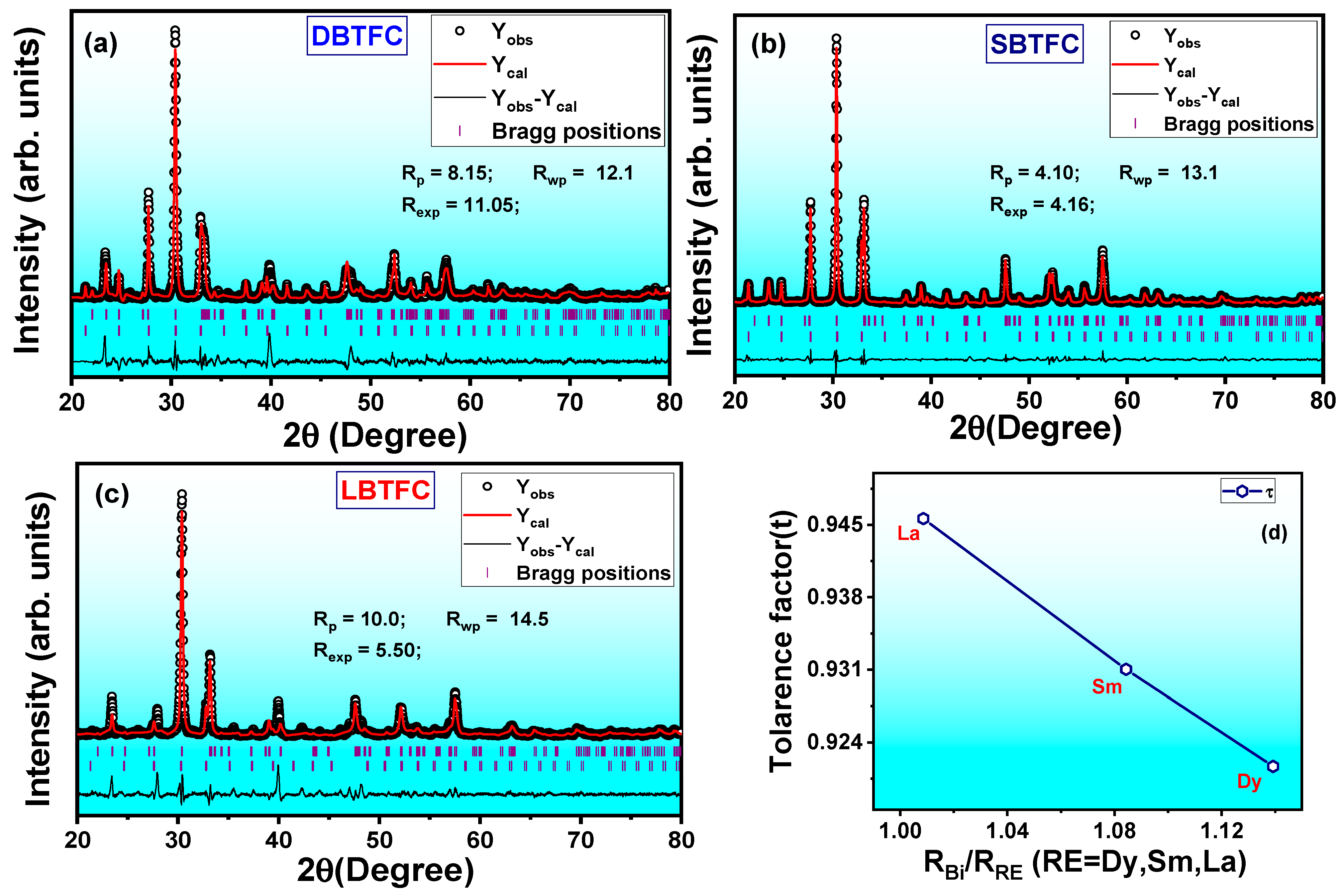

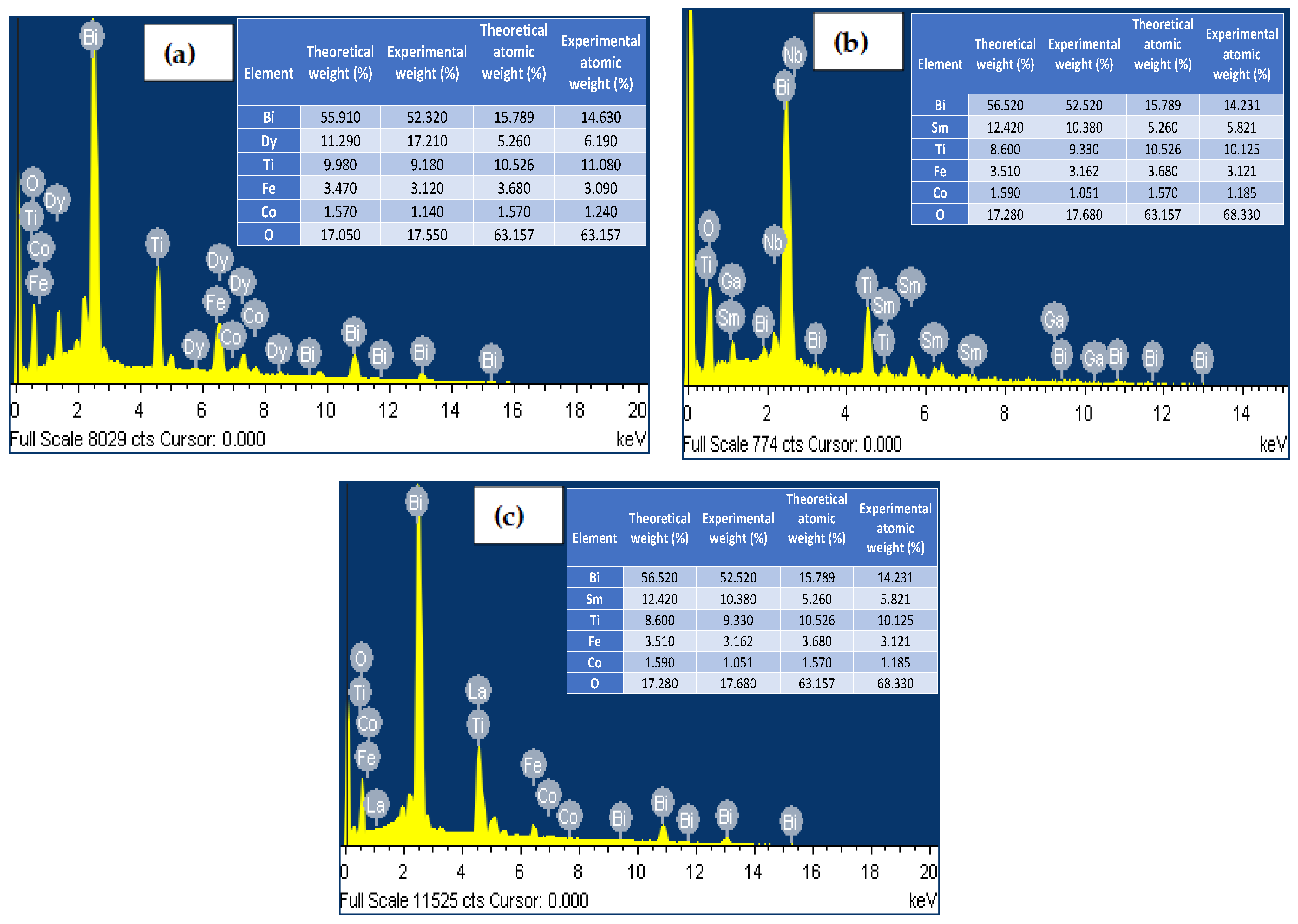
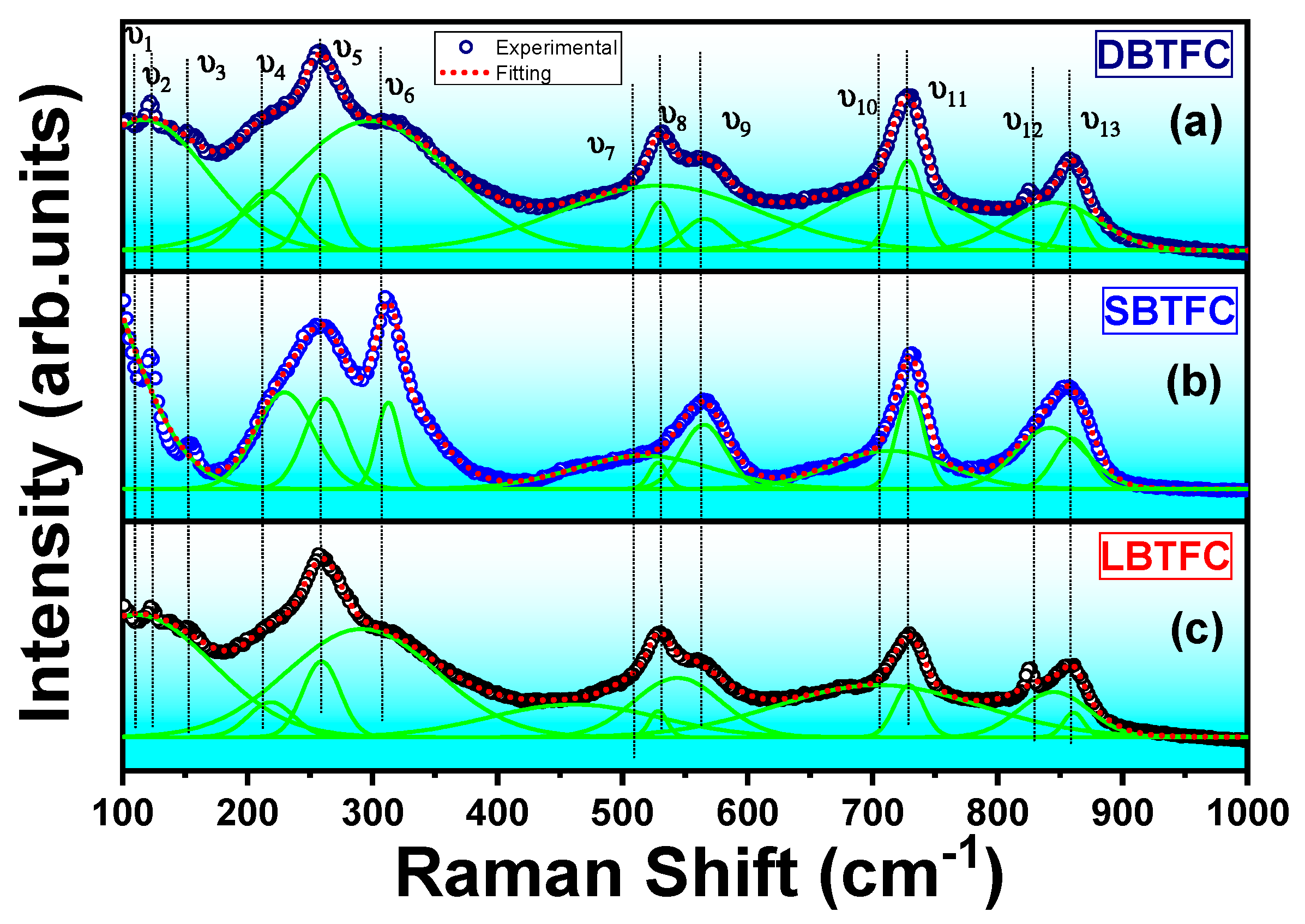

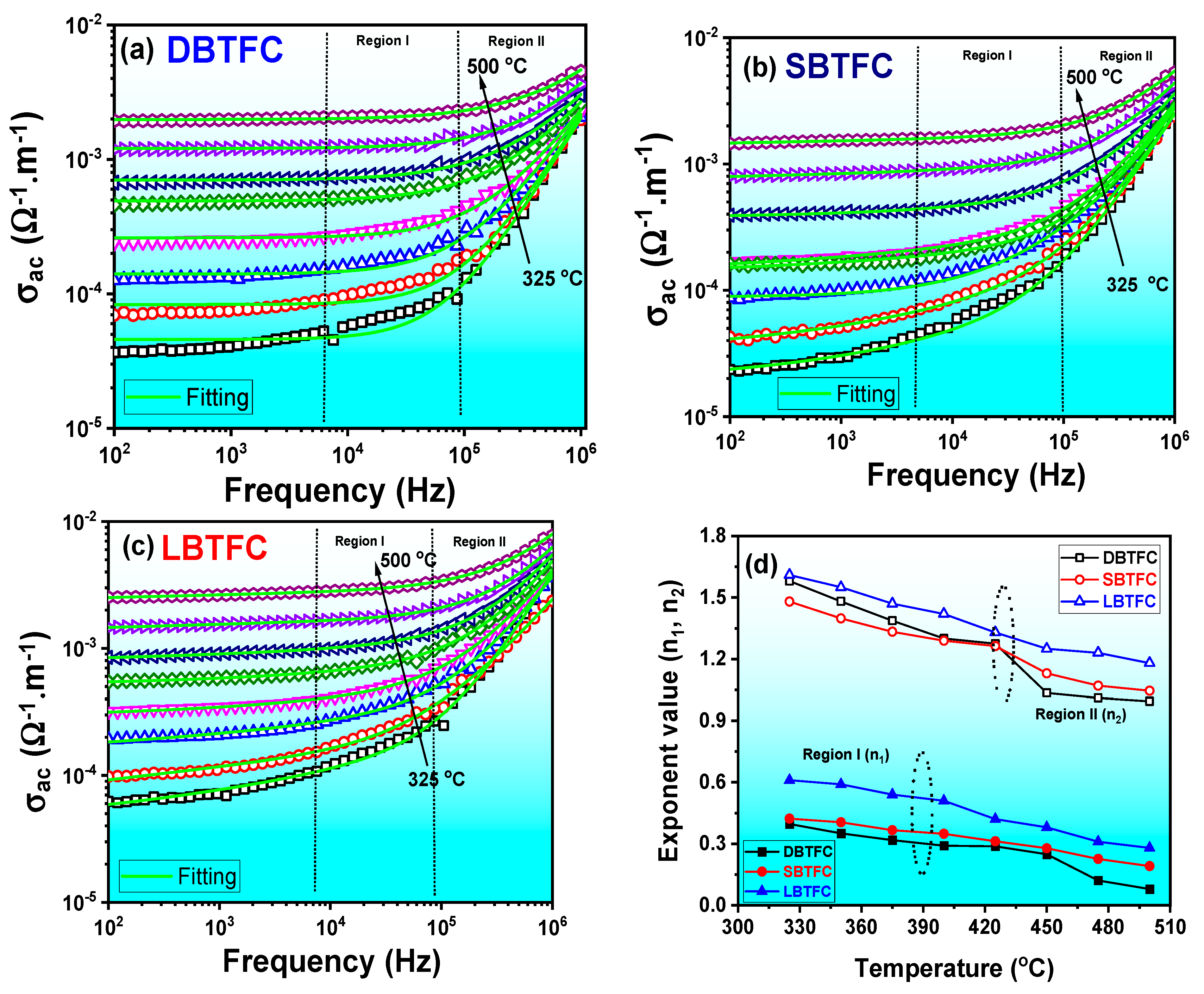
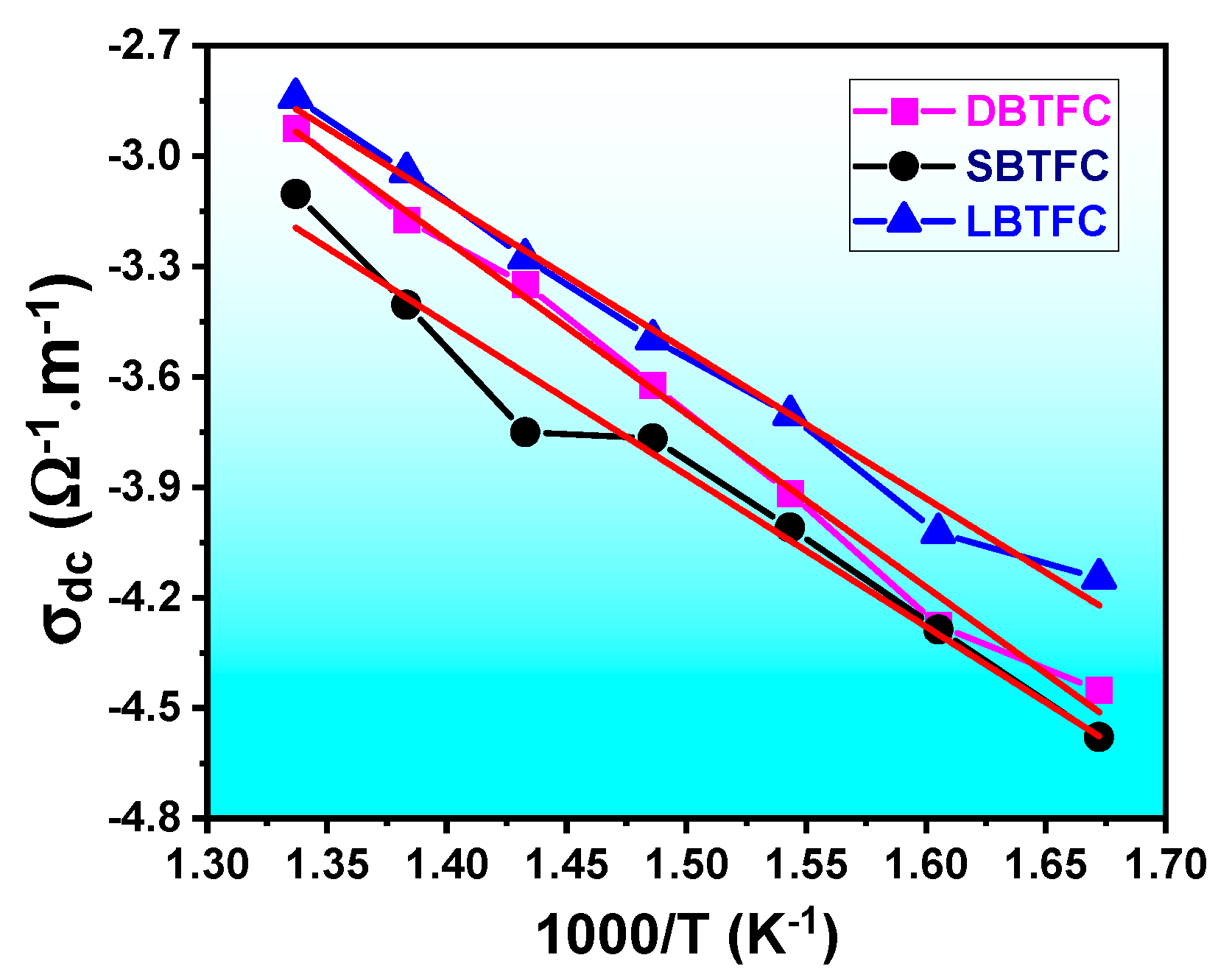
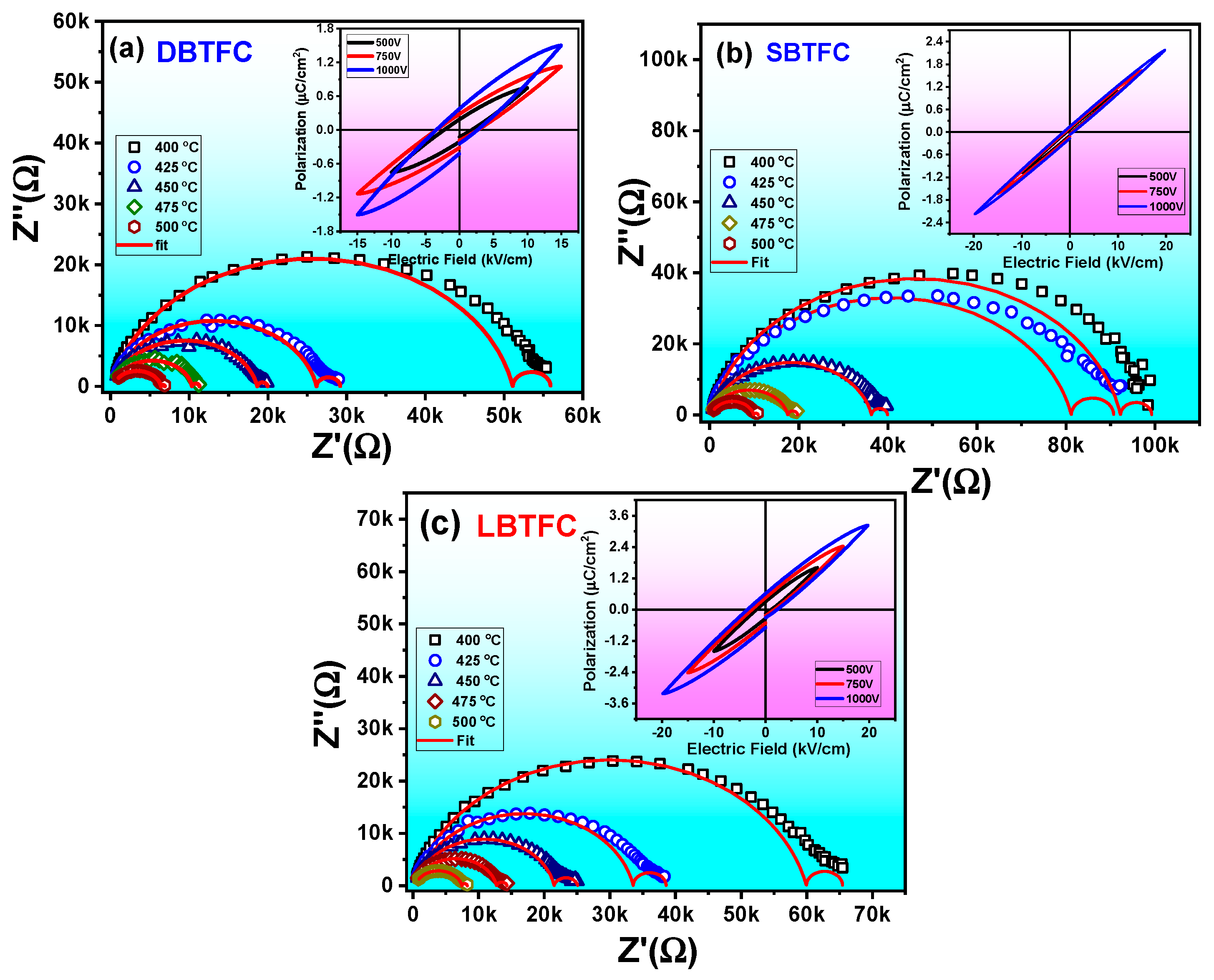
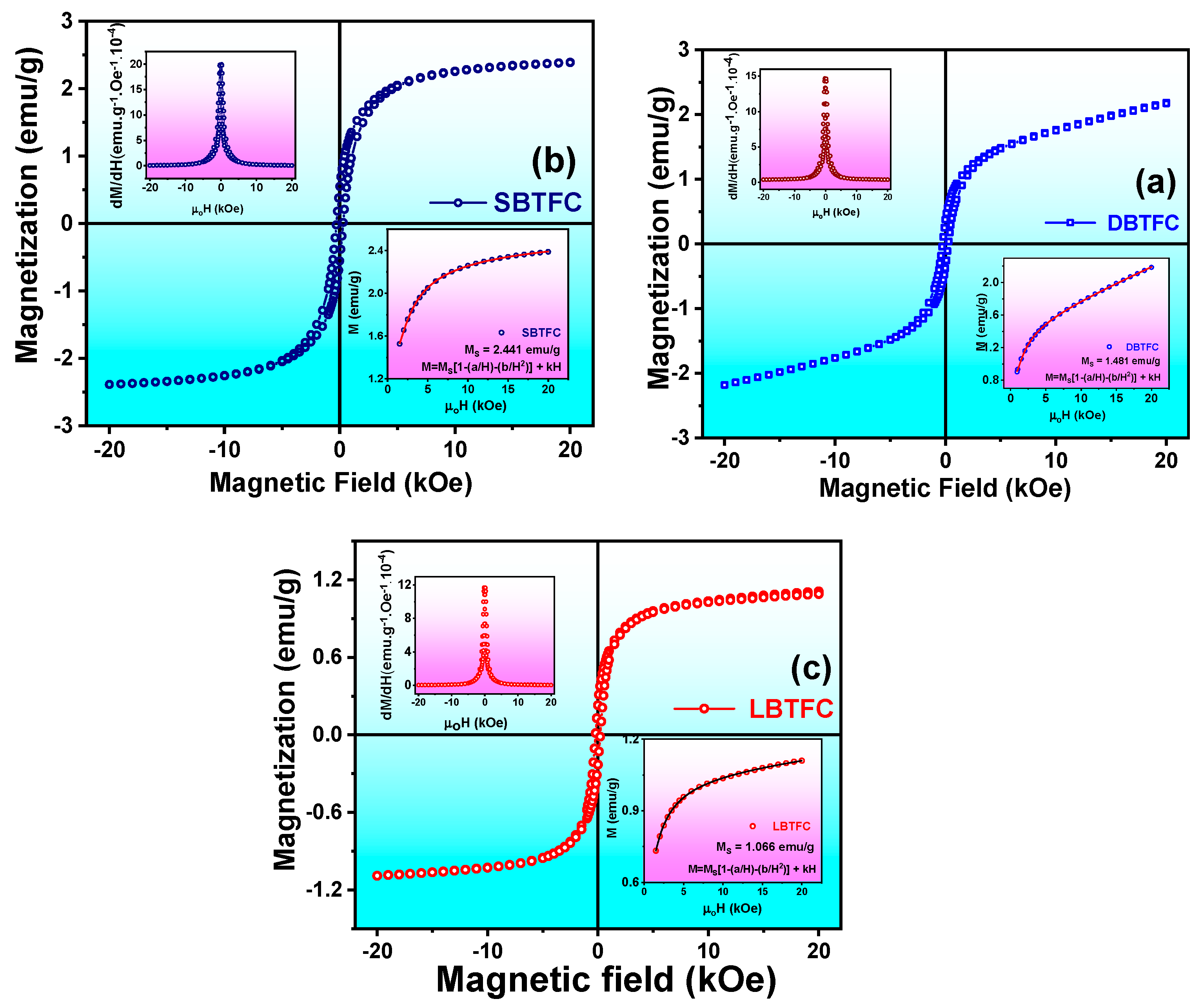

| Sample Name | DBTFC | SBTFC | LBTFC | |||
|---|---|---|---|---|---|---|
| Space group | Fmmm | I23 | Fmmm | I23 | Fmmm | I23 |
| Lattice parameters (Å) | a = 5.415 b = 5.381 c = 32.231 | a = 10.173 | a = 5.401 b = 5.400 c = 32.331 | a = 10.175 | a = 5.401 b = 5.399 c = 32.291 | a = 10.220 |
| Volume fraction (%) | 82.300 | 17.700 | 79.78 | 20.22 | 99.70 | 0.300 |
| Reliability factors (%) | Rp = 8.15; Rwp = 12.10; Rexp = 11.05 | Rp = 4.10; Rwp = 13.10; Rexp = 4.16 | Rp = 10.01; Rwp = 14.50; Rexp = 5.50 | |||
| Goodness of fit (χ2) | 5.88 | 9.95 | 6.90 | |||
| Sample Name | DBTFC | SBTFC | LBTFC |
|---|---|---|---|
| Orthorhombic Distortion (b/a) | 0.993 | 0.9998 | 0.9996 |
| Tetragonal strain (c/a) | 5.9521 | 5.9861 | 5.9787 |
| Orthorhombicity (2(a − b)/(a + b) × 102) | 0.629 | 0.018 | 0.003 |
| DBTFC | ||||||||
|---|---|---|---|---|---|---|---|---|
| No. | Temperature (°C) | R1 (Ω) | R2 (Ω) | CPE-1 | n | R3 (Ω) | CPE-2 | n |
| 1 | 400 | 200 | 92,000 | 5.200 × 10−10 | 0.885 | 7000 | 3.40 × 10−4 | 1 |
| 2 | 425 | 240 | 84,000 | 7.500 × 10−10 | 0.87 | 6500 | 4.20 × 10−4 | 1 |
| 3 | 450 | 320 | 36,000 | 6.200 × 10−10 | 0.875 | 3600 | 4.60 × 10−4 | 1 |
| 4 | 475 | 340 | 17,200 | 4.9 × 10−10 | 0.88 | 2200 | 4.65 × 10−4 | 1 |
| 5 | 500 | 360 | 9500 | 7.80 × 10−10 | 0.86 | 1050 | 5.20 × 10−4 | 1 |
| SBTFC | ||||||||
| No. | Temperature (°C) | R1 (Ω) | R2 (Ω) | CPE-1 | n | R3 (Ω) | CPE-2 | n |
| 1 | 400 | 100 | 51,000 | 6.100 × 10−10 | 0.877 | 4800 | 9.9 × 10−4 | 1 |
| 2 | 425 | 180 | 26,000 | 5.700 × 10−10 | 0.882 | 3000 | 9.1 × 10−4 | 1 |
| 3 | 450 | 250 | 18,400 | 5.500 × 10−10 | 0.885 | 1300 | 8.2 × 10−4 | 1 |
| 4 | 475 | 350 | 10,100 | 4.400 × 10−10 | 0.895 | 950 | 7.9 × 10−4 | 1 |
| 5 | 500 | 380 | 6041 | 5.300 × 10−10 | 0.90 | 480 | 7.8 × 10−4 | 1 |
| LBTFC | ||||||||
| No. | Temperature (°C) | R1 (Ω) | R2 (Ω) | CPE-1 | n | R3 (Ω) | CPE-2 | n |
| 1 | 400 | 150 | 59,800 | 9.900 × 10−10 | 0.862 | 6000 | 5.0 × 10−4 | 1 |
| 2 | 425 | 280 | 33,284 | 6.400 × 10−10 | 0.880 | 5000 | 4.1 × 10−4 | 1 |
| 3 | 450 | 300 | 21,200 | 6.200 × 10−10 | 0.89 | 3600 | 4.5 × 10−4 | 1 |
| 4 | 475 | 320 | 12,400 | 6.1 × 10−10 | 0.886 | 1600 | 4.7 × 10−4 | 1 |
| 5 | 500 | 350 | 7100 | 9.50 × 10−10 | 0.86 | 800 | 5.2 × 10−4 | 1 |
Disclaimer/Publisher’s Note: The statements, opinions and data contained in all publications are solely those of the individual author(s) and contributor(s) and not of MDPI and/or the editor(s). MDPI and/or the editor(s) disclaim responsibility for any injury to people or property resulting from any ideas, methods, instructions or products referred to in the content. |
© 2024 by the authors. Licensee MDPI, Basel, Switzerland. This article is an open access article distributed under the terms and conditions of the Creative Commons Attribution (CC BY) license (https://creativecommons.org/licenses/by/4.0/).
Share and Cite
Veenachary, V.; Ramana, E.V.; Narendra Babu, S.; Puli, V.S.; Saha, S.; Srinivasan, G.; Prasad, G.; Prasad, N.V. Magnetoelectric Properties of Aurivillius-Layered Perovskites. Crystals 2024, 14, 299. https://doi.org/10.3390/cryst14040299
Veenachary V, Ramana EV, Narendra Babu S, Puli VS, Saha S, Srinivasan G, Prasad G, Prasad NV. Magnetoelectric Properties of Aurivillius-Layered Perovskites. Crystals. 2024; 14(4):299. https://doi.org/10.3390/cryst14040299
Chicago/Turabian StyleVeenachary, Vadla, Eskilla Venkata Ramana, Simhachalam Narendra Babu, Venkata Sreenivas Puli, Sujoy Saha, Gopalan Srinivasan, G. Prasad, and N. V. Prasad. 2024. "Magnetoelectric Properties of Aurivillius-Layered Perovskites" Crystals 14, no. 4: 299. https://doi.org/10.3390/cryst14040299
APA StyleVeenachary, V., Ramana, E. V., Narendra Babu, S., Puli, V. S., Saha, S., Srinivasan, G., Prasad, G., & Prasad, N. V. (2024). Magnetoelectric Properties of Aurivillius-Layered Perovskites. Crystals, 14(4), 299. https://doi.org/10.3390/cryst14040299









